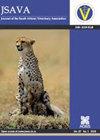猎豹捕获相关死亡率相关因素的兽医调查
IF 0.9
4区 农林科学
Q3 VETERINARY SCIENCES
Journal of the South African Veterinary Association
Pub Date : 2019-07-31
DOI:10.4102/jsava.v90i0.1723
引用次数: 6
摘要
这项研究的目的是更好地了解猎豹捕获相关死亡率的相关因素。通过物种生存计划和欧洲濒危物种计划协调员以及“野生动物兽医网”谷歌小组论坛,向动物园和野生动物兽医发送了一个在线问卷链接。问卷由50个问题组成,涉及兽医的居住国和经验、使用的药物组合、标准监测程序、捕获相关并发症以及该物种在不同捕获条件下经历的死亡率。此外,还检查了南非国家动物园国家野生动物疾病数据库中的尸检数据,以确定麻醉死亡被列为猎豹死亡原因的病例。共有75名兽医完成了这项调查,其中38名来自非洲国家,37名来自欧洲、美国和亚洲。其中,24%(n=18/75)的猎豹至少经历过一次与捕获相关的死亡,几乎所有的死亡(29/30)都是由在非洲工作的兽医报告的。缺乏麻醉监测和缺乏补充氧气被证明是导致死亡的重要风险因素。热疗可能与捕获应激有关,是最常见的并发症(35%)。研究结果表明,自由放养而非习惯圈养的猎豹在固定和运输过程中尤其有死亡的风险。该物种中与捕获相关的死亡似乎与兽医的临床经验水平或使用的固定剂无关。本文章由计算机程序翻译,如有差异,请以英文原文为准。
A veterinary survey of factors associated with capture-related mortalities in cheetahs (Acinonyx jubatus)
The objective of this study was to gain better insight into factors associated with the capture-related mortality rate in cheetahs. A link to an online questionnaire was sent to zoo and wildlife veterinarians through the Species Survival Plan Programme and European Endangered Species Programme coordinators and via the ‘Wildlife VetNet’ Google group forum. The questionnaire consisted of 50 questions relating to the veterinarians’ country of residence and experience, the medicine combinations used, standard monitoring procedures, capture-related complications and mortalities experienced in this species under different capture conditions. In addition, necropsy data from the national wildlife disease database of the National Zoological Gardens of South Africa were examined for cases where anaesthetic death was listed as the cause of death in cheetahs. A total of 75 veterinarians completed the survey, with 38 from African countries and a combined total of 37 from Europe, the United States (US) and Asia. Of these, 24% (n = 18/75) had experienced at least one capture-associated cheetah mortality, with almost all of the fatalities (29/30) reported by veterinarians working in Africa. A lack of anaesthetic monitoring and the absence of supplemental oxygen were shown to be significant risk factors for mortality. Hyperthermia, likely to be associated with capture stress, was the most common reported complication (35%). The results suggest that free-ranging rather than habituated captive cheetahs are particularly at risk of dying during immobilisation and transport. The capture-related fatalities in this species do not appear to be associated with either the veterinarian’s level of clinical experience or the immobilisation agents used.
求助全文
通过发布文献求助,成功后即可免费获取论文全文。
去求助
来源期刊

Journal of the South African Veterinary Association
VETERINARY SCIENCES-
CiteScore
1.50
自引率
0.00%
发文量
23
审稿时长
22 weeks
期刊介绍:
The Journal of the South African Veterinary Association is a contemporary multi-disciplinary scientific mouthpiece for Veterinary Science in South Africa and abroad. It provides veterinarians in South Africa and elsewhere in the world with current scientific information across the full spectrum of veterinary science. Its content therefore includes reviews on various topics, clinical and non-clinical articles, research articles and short communications as well as case reports and letters.
 求助内容:
求助内容: 应助结果提醒方式:
应助结果提醒方式:


